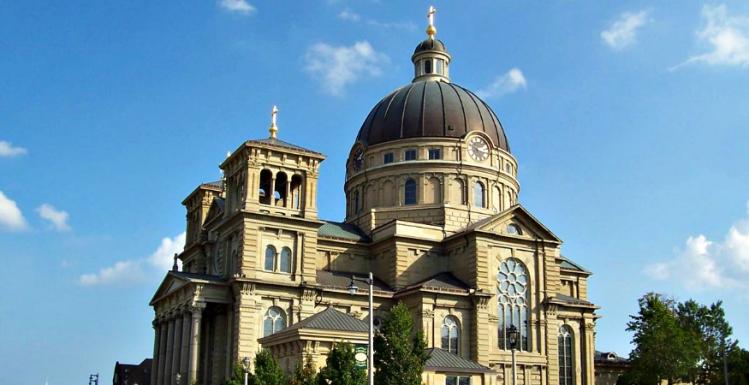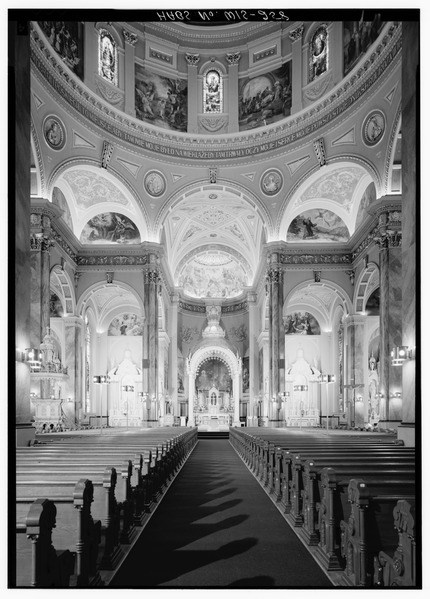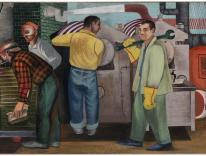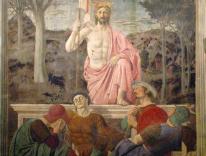
On an urban block on the south side of Milwaukee stands the grand Basilica of St. Josaphat. Though that part of town is crowded nowadays with Spanish bodegas, the church remains a testament to the Polish immigrants who flooded the neighborhood in the late nineteenth century and named their parish after the Polish monk martyred in 1623 during the conflict between Orthodox and Eastern-rite Roman Catholics. Within a decade following its 1888 founding, the parish swelled to more than twelve thousand members, becoming the largest in the Archdiocese of Milwaukee. Soon the initial church was too small, and so the pastor, Fr. William Grutza, sought to build a new one.
Grutza hired the renowned Milwaukee architect, Erhard Brielmaier, and together the two men, both immigrants themselves, set out to fashion a church that would emulate the cathedrals they had left behind in Europe—a structure grand enough to inspire the impoverished families who were St. Josaphat’s parishioners. These newly transplanted Polish families didn’t have it easy. They sent their men to work sixty-hour weeks in Milwaukee’s smoky, claustrophobic steel mills and tool works, while their wives and daughters worked equally hard cooking meals, scrubbing factory-stained clothes, and caring for their many children.
For us looking back today, the stark contrast between such an elaborate and costly building as St. Josaphat and the lives of the hard-laboring men and women who worshiped there raises challenging questions. What is the role of beauty for those who live in such drab and difficult conditions? What human emotions attach to the perception of beauty, and which kinds of architecture, sculpture, and painting best bring forth those emotions? And finally, is a richly ornate—and staggeringly expensive—structure like St. Josaphat justifiable in a social sense? Should we view it—and the enormous and elaborate churches of the Middle Ages, Renaissance, and eighteenth-century Europe that were its models—as magnificent monuments to the spirit or as needless displays of earthly power?
These moral and aesthetic questions are of more than historical interest; today many parishes are struggling to restore old churches in neighborhoods where church attendance has dwindled, while others are building new churches in places where the Catholic population is growing. Bethe Dufresne’s profile of liturgical designer Lawrence Hoy (“A Sermon in Stone,” June 1) touched on many of these questions. I think St. Josaphat provides a similar view into the nature of beauty and its function—and offers a key to understanding why the church, should it ever abandon its quest to preserve and create magnificent places of worship, will only further the spiritual impoverishment of the poor.
***
The opportunity to tour St. Josaphat arose this past summer when I went to Milwaukee to visit my brother, who helped raise funds for the basilica’s restoration. By way of preparing myself, I had philosopher George Santayana’s 1896 treatise The Sense of Beauty on my Kindle. Santayana, who called himself an “aesthetic Catholic,” is said to have brought beauty down to earth and American aesthetic theory to maturity. I wondered what he would say if he were present as I walked through St. Josaphat’s imposing neoclassical façade and entered a space large enough to accommodate more than two-thousand congregants.
I craned my neck to stare in wonder, trying to take it all in: the soaring dome, adorned with paintings of biblical stories in brilliant hues; a Corinthian-columned baldachino topped with a ruby lantern that canopied the elaborately carved tabernacle at the main altar; four marble-statued side-altars flanking the main altar, one with a gilded statue of the Virgin of Guadalupe; twisted columns, painted to resemble multicolored granites; a pure white, Italian marble pulpit towering on high; statues of angels with golden wings holding lamps that light a main altar populated with statues of the Virgin and other saints; Christ- and Virgin-figured stained-glass windows, topped with rose windows or lunettes; and so much more.

Feeling all but overwhelmed by the splendor around me, I wondered what to make of St. Josaphat. It was obviously beautiful, but was it truly beautiful? Many critics have dismissed these styles as decadent imitations of the Baroque and Rococo employed by the Catholic Church during the Counter Reformation. Some would say that even St. Peter’s Basilica in Rome borders on the vulgar, and that simplicity of design is the only true way to perfection: a New England Presbyterian church, say, built during the Federal period, with a classic Doric-columned porch, a plain white interior, and clear, evenly spaced windows.
I know just such a Presbyterian church; I have been inside it several times for weddings. I am always struck by the single, centered, perpendicular window over the sanctuary. A tree stands in full-length view just outside that window. While I do find this church beautiful, it is partly because it serves as a frame for that happily placed maple tree, ornately dressed in fall colors or naked in winter, a remarkable amalgamation of sinuous lines glistening with falling snow.
It was not until I read Santayana that I understood why this plainer church might lose interest without the beauty of the tree outside. In its classic simplicity, Santanaya would say, the plain church is somewhat like the most perfect abstract form, the circle. Yes, the circle is beautiful, but it is so final and determined in its form that it becomes less interesting over time, unlike the tree that the window frames. As Santayana points out, even the Greeks moved from the pure, repetitive lines of the Parthenon to St. Sophia. I believe that St. Josaphat is like the tree, endlessly changing no matter when or where you look; like the tree’s living branches, it is indeterminate, holding your attention through its very changeableness.
I know someone who thought that even trees are guilty of bad taste—a woman who prided herself on aesthetic sensitivity and who confessed to me long ago that she despised fall foliage because it was “too gaudy.” (A similar judgment is common in garden-club circles: the tuberous dahlia, for instance, too large and vividly colored in purples, reds, yellows, and pinks to be planted by any respectable gardener, is left to benighted old men, perhaps retired English colonels.) There exists an American prejudice, deriving from our Puritan heritage, against the ornate and the colorful—an intolerance that correctly identifies the Baroque and the Rococo with the papacy and Rome. Thus, even fall foliage and brightly colored flowers are scorned as the equivalents in nature of these styles.
***
Yet for those who celebrate and protect this kind of beauty, the question remains: Is it worth the cost? Beauty’s rarity can raise its price to formidable heights. A Wall Street hedge-fund manager recently spent $155 million for one painting by Picasso, and houses along the Hudson River, near where I live, are out of reach for all but those contemporary Astors and Vanderbilts who reign in our new Gilded Age.
As for St. Josaphat, to the practical-minded—and even to those who simply believed in moderation—the plan that Fr. Grutza adopted from Erhard Brielmaier was wasteful. The initial cost of the building was estimated at $150,000 (in today’s money, roughly $3 million), but the final, actual cost reached more than twice that amount. Though the parish was large, its immigrant families were poor, and indeed it was not until 1925—more than two decades after the basilica’s dedication—that the debt was paid off, allowing the decoration of the interior to begin at last.
The basilica is now over a hundred years old. During the 1950s and ’60s it fell into disrepair through lightning strikes, electrical fires, water damage from storms, and what might be called benevolent vandalization, when the colorful interior was painted almost all white. Its resurrection meant that millions more had to be raised. This time it was obvious that parishioners could not sustain the cost; many of the original Polish families had moved to the suburbs, and the new immigrants were perhaps even poorer than their predecessors. The Milwaukee business community was called on, and responded with crucial support—and with the new understanding that St. Josaphat, while still a Catholic parish, would be available to all, as the site of Milwaukee Symphony Orchestra and Bel Canto Chorus concerts.
How much has the basilica cost over the past century? It is hard to estimate, but the rough answer is: many millions. Would a simpler structure have been more appropriate? Instead of restoration, should money have been raised for the poor? Of all the arguments against erecting such a monument, this is the most potent: Let us feed and clothe and house the poor, rather than build grand churches. Along these lines, is it not ironic that it is the Franciscan Order of Friars Minor, founded by the Apostle of Poverty, which now owns and administers the parish? Of all religious orders, Franciscans might be expected to argue most passionately for feeding and clothing the poor. Why spend for beauty, when those who crave it can find it in art museums, or in the public parks and beaches that line Milwaukee’s Lake Michigan? After all, to individuals who are resourceful in looking for beauty, a leaf fluttering in the wind can evoke it. So why divert millions that could feed the hungry?
To answer these very reasonable objections, Santayana in On Beauty argued that “the wider diffusion of sensuous beauty makes it as it were the poor man’s good.” I would add that the beauty of a church like St. Josaphat provides a free education in aesthetics. Yet the ultimate answer, I think, is more fundamental still. The truth is that beauty is intrinsic in any religious setting; religion after all is the expression of the ideal, of perfection. It is true that the earliest Christian churches were simply meeting places in homes, and of course in the Catacombs. But quite early on, as the church developed, more elaborate places of worship were built. Santa Maria Trastevere, the oldest existing Catholic church in Rome, was built in 333 A.D., and it is thought that the original structure used columns from either the Baths of Caracalla or the Temple of Isis. The Pantheon built by Marcus Agrippa was converted into a Catholic church in the early 600s. The idealized image of Christ, wrote Santayana, “has inspired all the conversions, all the penances, charities, and sacrifices, as well as half the art of the Christian world.”
One need only look at San Marco in Venice, or at Salisbury Cathedral, to see that this is true. They were built in “the Age of Faith,” and it was faith, not practicality, that raised up such monuments. Many of the people who built them lived in hovels and wore rags; even their lords and masters were poor by today’s standards. It is not only practicality, but a failure to recognize the aesthetic aspects of faith that allows some to view a mundane community hall, suitable for PTA meetings, as a proper setting for worship. I believe that first-century Christians would have joyously welcomed St. Peter’s had they possessed the resources (and permission from the Roman Emperor) to build it. After all, many of them had memories of the recently destroyed and much mourned Jewish Temple in Jerusalem.
Like Santayana, the novelist Albert Camus commented frequently on aesthetics. In The Myth of Sisyphus he famously asserted that life was “absurd” because it had no meaning, and that the “lucid” man realized the inevitability of final, unending nonexistence. Camus believed that it is only the “overloading and pretension to the eternal’’ that prompts man to create art larger than himself.
Say what you will about Camus’ view of life’s absurdity, but he was absolutely dead-on about art. It was belief in the eternal that brought about Chartres, with its flying buttresses, and St. Peter’s and St. Josaphat, with their soaring domes. I believe that Christians should continue to embrace such magnificence. Indeed, those who claim a “pretension to the eternal,” like Fr. Grutza, cannot do otherwise when facing the task of conceiving a house of God. And neither can we. St. Josaphat may not be the model for the churches we build today, but that is no excuse for not using the Berninis of today—the best modern aesthetic thought, the best materials available—to construct churches that will stand as monuments for centuries to come.
Please email comments to [email protected] and join the conversation on our Facebook page.
Share
Previous Story
Whose Recovery?
Next Story
You Will Be Missed


